|
Exercise PACIFIC LONGLOOK, January-April 2019
by Lieutenant T S Minihan
Welsh Guards
|
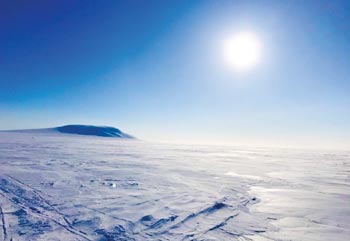 Patrolling the sea ice, 5km south of Resolute Bay
Patrolling the sea ice, 5km south of Resolute Bay |
It is impossible to deploy to the Canadian Arctic without first sitting through various briefs on what can hurt and kill you in that environment. We had been told that it takes roughly two minutes to sustain severe frostbite at -50˚C, and that with the limited medical support on offer, the affected area would almost certainly require amputation. Falling through the sea ice can cause a heart attack within ten seconds, causing the casualty to drown. Even if one were rescued from the sea, the exposure to water at that temperature would lead to hypothermia and almost certain death. We were also continually reminded of the threat of Polar Bear attacks. The creatures, we were informed, would be in the middle of their mating season when we arrived in the Arctic and therefore especially aggressive. Pictures of the mangled flesh and bone of some prior victim would usually follow at this point, along with a comforting reminder that your rifle would be better employed as a club at those temperatures.
In March 2019, with this myriad of fatalities fresh in my mind, I deployed on Operation NUNALIVUT 19 to Resolute Bay in Nunavut, a province of the Canadian High Arctic. I was attached to Charles Company, 1st Battalion Royal Canadian Regiment (1 RCR), with whom I had worked and trained since I arrived in Canada on Exercise PACIFIC LONGLOOK in January 2019. Operation NUNALIVUT is an influence operation, designed to deter Russian incursion, both military and commercial, into Canadian sovereign territory in the Arctic. Russia and Canada are acutely aware of the vast natural resources in the Arctic Circle, an area in which a quarter of the land mass is Canadian. Events in the Crimea in 2014 demonstrated to the world that what Russia needs, Russia will take. Our force projection from our base in Petawawa, a garrison town outside Ottawa, up to Resolute Bay, was broadcast on social media and the operation received much interest from national and international news networks. A visit for over thirty journalists and VIPs was scheduled as Charles Company crossed the line of departure to deploy even further North from Resolute Bay. Our mission was to conduct a series of point reconnaissance patrols and establish air strips on the sea ice to allow the Royal Canadian Air Force’s aircraft to land. In doing so we would be testing and proving joint capabilities.
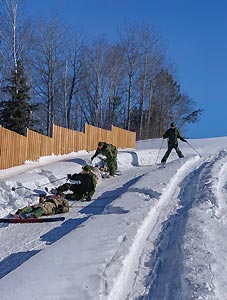 Lieutenant Minihan (far left) demonstrating perfect technique to his platoon on the Battalion ski school, Petawawa
Lieutenant Minihan (far left) demonstrating perfect technique to his platoon on the Battalion ski school, Petawawa |
The mission represented months of preparation that had begun in January with a basic winter warfare exercise in Petawawa. During this exercise, temperatures reached -25˚C, cold enough for me but only a taste of things to come. Preparation continued with snowmobile courses, a military ski school, winter ranges and snow-shoe marches. It was clear that emphasis was being placed on spending long periods of time outdoors, testing kit, learning from mistakes and developing skills. What was impossible to fully develop in Petawawa was the mental resilience required for the weather conditions that we would encounter in the Arctic. The average temperature in Resolute Bay in March is -40˚C, with the wind chill pushing that figure down to as low as -65˚C.
As soon as I stepped off the C17 in Resolute Bay I could understand why we had been lectured to such a degree about the effects of cold on the body. The wind bites at any exposed skin, causing a burning sensation as soft tissue begins to freeze. Cold air slowly seeps through your clothing, punishing the joints in your legs and arms and causing your fingers and toes to throb with a dull pain until eventually the blood drains out of them. The only remedy for this pain is to move, constantly and with purpose. Failing to pitch your tent and light a stove within fifteen minutes could mean severe hypothermia. Losing a glove in the snow whilst working was to welcome frostbite. Suddenly, the briefs we had received were no laughing matter. Our ability to soldier was being tested rigorously by the environment. Survival required the most rigid and uncompromising discipline. One can only imagine the challenges of fighting an enemy in the Arctic.
Despite the absence of an enemy, we did our very best to try and kill each other. Night time in the Arctic is spent inside purpose built ten-man tents, warmed by a small and notoriously unreliable camping stove. Tent groups must take turns watching the stove, ensuring that both it and the gas lantern are fuelled, pumped and burning clean. The temperature dropped so significantly at night that the fuel, stored outside, began to turn into a slushy, icy mixture that became volatile and unstable when burnt. The choice was as follows: freeze to death or quite possibly burn your tent down. By the third night we had tempted fate quite enough and the inevitable happened. I was awoken at 0400hrs by shouts of ‘fire, fire, fire!’. Five-foot flames were shooting from the stove and licking the roof of the tent which filled with black smoke as it began to catch fire. I crawled out of the door, grabbing as much clothing as I could. The sudden plunge into freezing temperatures was a severe shock and I had to concentrate more than ever on pulling on items of clothing before hypothermia set in. To say that I escaped with my life would be a massive over-exaggeration, but Charles Company was rife with gallows humour for the days that followed, sure in the knowledge that there would be many more tent fires before the end of the exercise.
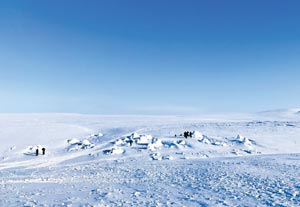 8 Platoon, Charles Company build improvised snow shelters on Cornwallis Island
8 Platoon, Charles Company build improvised snow shelters on Cornwallis Island
|
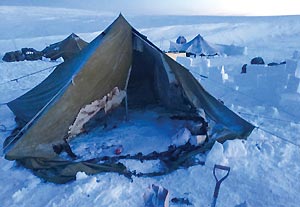 The aftermath of a tent fire in the early hours of the morning. Fortunately, my own experience was nowhere near as severe
The aftermath of a tent fire in the early hours of the morning. Fortunately, my own experience was nowhere near as severe |
The opportunity to operate in the Canadian Arctic was, despite all of this, a thoroughly enjoyable one. A highlight was spending time working with the Canadian Rangers, an Inuit force element of the Canadian Army who specialise in Arctic survival and fieldcraft. Their lessons included ice fishing and building snow shelters and their knowledge of the sea ice was indispensable on patrol. On more than one occasion did a Ranger, leading a patrol, suddenly stop and shy away from his planned route. We came to learn that this was a sign that he was not happy with the feel of the sea ice under his sled at this point and was leading us away from what may well have been a fatal accident.
The time I spent in Canada was a genuine privilege. I was warmly welcomed and well looked after by 1 RCR throughout my time with them. They are an infantry battalion with a proud history who deploy regularly to Latvia and Ukraine, bolstering NATO’s presence along Russia’s border. The standards maintained by all ranks within Charles Company were outstanding and I was humbled to learn a great deal from them. I would like to thank Major John Doig and Lieutenant Colonel Aaron Williams for their mentoring and kindness, and the men of 8 Platoon, Charles Company, who taught me far more than I taught them.
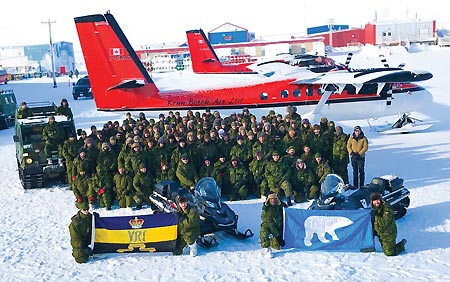 Charles Company still smiling at the end of the exercise
Charles Company still smiling at the end of the exercise |
|
|





